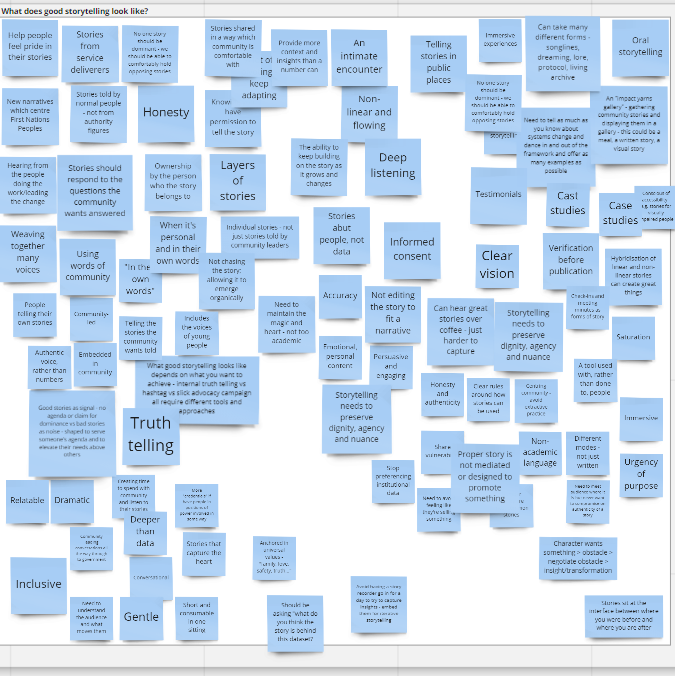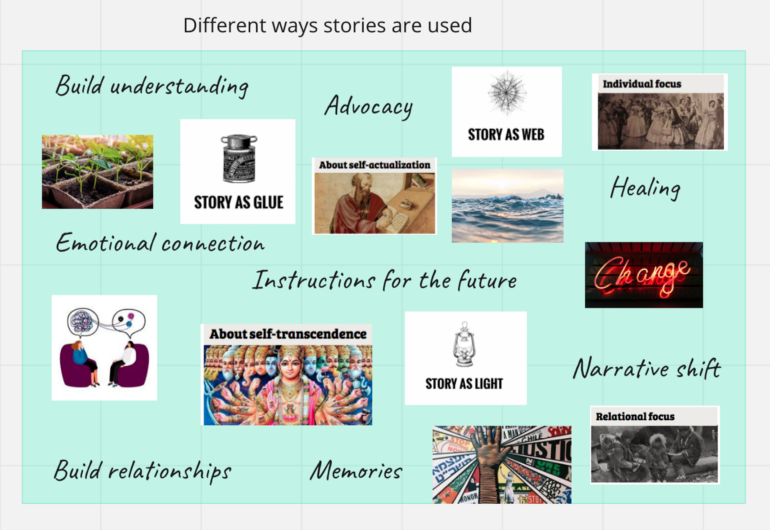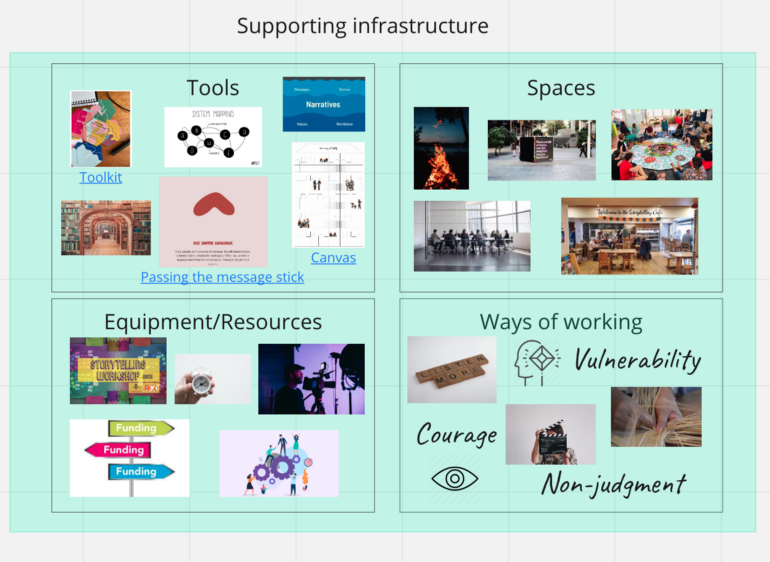
Storytelling for Systems Change: Early insights from communities and storytellers


.@CPI_foundation, @DusseldorpForum, & @handsupmallee have kicked off a project together exploring storytelling for systems change.
Share articleWe spent July and August listening to people share their ideas around storytelling — why stories are important, why it can be hard to tell stories, and how they use storytelling in their organisations or community.
Share articleThis blog focuses on the how of the workshop, rather than the what. We’ve done this deliberately, to share our process — what went well, and what went less-well
Share articleWe put our vision for government into practice through learning partner projects that align with our values and help reimagine government so that it works for everyone.
Back in July, the Centre for Public Impact, Hands Up Mallee and the Dusseldorp Forum began working together on a project exploring storytelling for systems change.
We spent July and August listening to people share their ideas around storytelling — why stories are important, why it can be hard to tell stories, and how they use storytelling in their organisations or community. The storytellers, community members, and others we spoke to shared some brilliant insights, which we summarised in this blog. As we wound up the listening process, we needed to work out what to do with those insights, and what our next steps would be.
One of the key principles in our Team Charter is a commitment to collaboration and empowerment. Our Charter states (amongst other things) that we:
conduct interactions in a way that is empowering for people and communities — the way we work is as important as the final product
always keep in mind that collaboration with communities is at the heart of the work.
With this as our guiding approach, it was clear that the next step in the process would need to involve those we’d listened to. Rather than harvesting data, and working to analyse that ourselves, we wanted to share the information back with the people who had so generously shared with us, and work collectively to generate insights and ideas.
And so, we developed a 2-hour workshop, which we invited all of those involved in the listening phase of the project to join. This blog shares some of our reflections on this workshop.
This blog focuses on the how of the workshop, rather than the what. We’ve done this deliberately, to share our process — what went well, and what went less-well — so that others can use the things about this process that feel exciting, as well as learn from our mistakes. Our final blog in the series will focus on what emerged from this process.
Teya Dusseldorp, Executive Director of the Dusseldorp Forum, welcomed attendees to the workshop. She explained that the first half would centre on working together with the knowledge generated during the listening sessions, while the second half would focus on developing creative solutions for what is needed to empower those involved in community-led systems change work to tell compelling stories that support change.
Teya shared with attendees her excitement that we were all working together to craft something special from the powerful insights generated from their contributions during the listening phase. Many of the attendees had not previously had a chance to meet or work together, so they were paired off into breakout rooms to introduce themselves and, in the spirit of storytelling, to share the story of their names.
Because the best stories come from deep listening, the sensemaking session aimed to reflect on what we had heard during the listening phase and make sense of it through collaborative theming.
To prepare for the session, we created four Miro boards corresponding to the questions asked in the listening phase:
Are stories important in creating change?
What does good storytelling look like?
What makes it hard to tell stories?
Other interesting things which don’t fit anywhere else.
Each board was pre-populated with ‘stickies’, which captured all of the insights from our listening session (in a slightly abridged format!). See an example here:
 The image above shows one of the sticky note boards from the sensemaking session
The image above shows one of the sticky note boards from the sensemaking session
Participants again broke off into small groups with facilitators Jane McCracken, Rachel Fyfe, David Marikumthara and Lila Wolff. Each group focussed their efforts on one board and worked to cluster the sticky notes into themes. We invited each group to consider the following questions:
What themes do you see emerging? Do some sit in tension others?
Are there any outliers (i.e. stickies that weren’t easy to categorise neatly)?
What does this help us understand?
What feels most significant in what we’re seeing?
The small size of each group made it easy for all group members to orient themselves to the ideas quickly and work collaboratively to identify patterns, outliers, and interesting insights. The groups were able to identify strong themes in their boards, with many such as power and ethics carrying across every area.
Every group shared back that they would have liked more time for this activity — 40 minutes wasn’t enough!
We wanted the workshop to be both reflective and generative. While the sensemaking part of the workshop offered a chance for reflection, we also wanted to create time and space for people to explore new ideas.
We have been fascinated by some work that’s happening at the moment on collective imagination, so we were keen to use this workshop as an opportunity to experiment with this as a practice.
In the Miro board, we created an inspiration canvas for people to spend some time exploring. We offered ideas around different kinds of stories, how stories are used, and what supporting infrastructure might be needed to support great storytelling.
 The first inspiration canvas for the imagination session — offering examples of different types of stories
The first inspiration canvas for the imagination session — offering examples of different types of stories
 The second inspiration canvas for the imagination session — offering ideas around the different ways stories are used
The second inspiration canvas for the imagination session — offering ideas around the different ways stories are used
 The second inspiration canvas for the imagination session — offering ideas around the different ways stories are used
The second inspiration canvas for the imagination session — offering ideas around the different ways stories are used
.png) The final inspiration canvas for the imagination session, offering ideas around the types of supporting infrastructure that might be needed to support better storytelling
The final inspiration canvas for the imagination session, offering ideas around the types of supporting infrastructure that might be needed to support better storytelling
Using these images and ideas as inspiration, we invited people to think audaciously. We invited them to let go of the constraints that normally temper our thinking — constraints imposed by time, by institutional norms, by budgets — and to think boldly about what they would love to see. What were the most creative possibilities for what stories might look like, and the form they might take? How might stories be used to both enable and showcase systems change work? And what kind of infrastructure would make this all possible?
People spent about 20 minutes working on their own, and then we came together to discuss and share as a group.
While some wonderful ideas emerged from this part of the session — stories as food, as song, as ceremony, sculpture — the organising team agreed that more time was needed for people to fully tap into a creative and free-flowing imagination session. We also feel, in retrospect, that the inspiration offered was too practical to inspire truly imaginative thinking — we should have offered some more audacious ideas ourselves to give people permission to do the same!
However, a definite success was the way that the Miro board and group conversation enabled people to build on each other’s ideas — this was the “collective” part. As people shared, the board kept growing, as people found inspiration based on what others were contributing.
With our listening, sensemaking and imagining now complete, we need to capture the insights this work has generated. As a team, we want to create a written artefact which codifies the insights that have emerged, and lays foundations for future work.
We are hoping to create a report that is action-oriented, accessible, and which honours the many people who have contributed to it.
In the spirit of collaboration, we’ll be sharing a draft of the report with all of those who have been involved in the listening phase, and the workshop, and inviting them to comment. We’ll work to incorporate their feedback before sharing more publicly.
The next, and final, instalment of this blog series will be our sharing of that report with you. We’re so excited to share some of the creative and inspiring ideas that have emerged.

We intend to keep sharing our learning from this Phase as we go. In the meantime, if you have any ideas, thoughts or questions about this project, we’d love to hear from you.